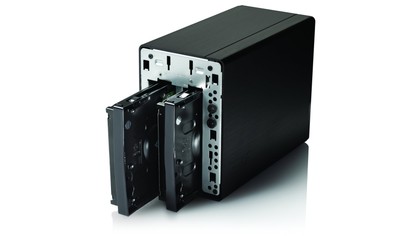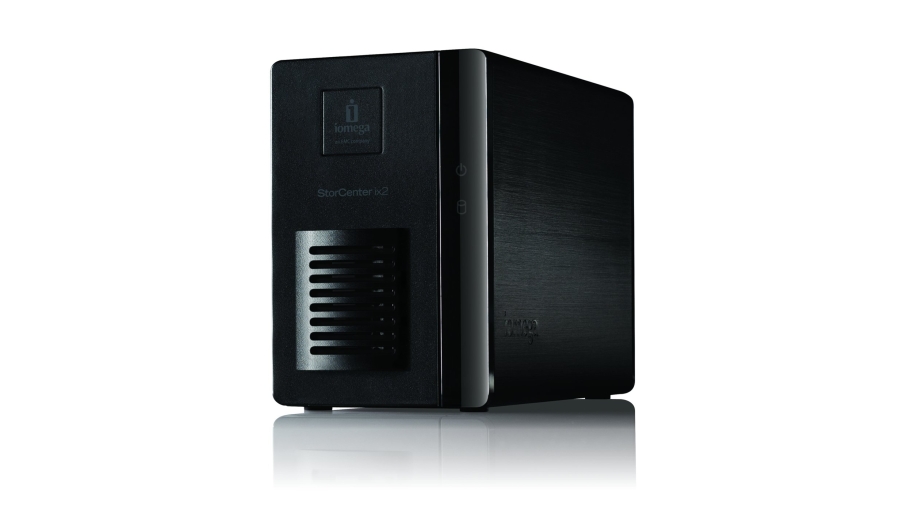TechRadar Verdict
Pros
- +
Local and remote user management
- +
Files accessible through cloud
- +
Support for cloud backup
- +
Potential for different storage options.
Cons
- -
Clumsy web console
- -
Upgrades a problem.
Why you can trust TechRadar
Despite its small size and unassuming design, the two-bay Iomega StorCenter ix2 packs in business features as well as performance.
You can buy models with a range of capacities (from diskless to 6TB); we looked at the two-disk 2TB version with RAID 1 mirroring, connected to a gigabit Ethernet network.
If you're fitting drives yourself the front panel snaps on and off easily and you don't need tools to pop a disk out or snap the drive rails onto a SATA II disk. You can also plug in an external USB drive as extra storage – or use the USB port to connect to a UPS that will shut down the StorCenter cleanly if you have a power failure.

Setup is straightforward, as long as your internet connection allows port forwarding. If that's enabled, you just plug an Ethernet cable into the StorCenter and visit www.myiomega.com to connect to the NAS, download's Iomega's Storage Manager software and enable the 'personal cloud' forwarding that lets you access the NAS shares when you're outside the office.
If port forwarding isn't available, you'll still see the links to download the software so you can create an account and access the StorCenter, through your browser or in Explorer on the desktop (Storage Manager automatically maps drives for the six default shares of backup, documents, movies, music, pictures, and shared media). You can set up the 'personal cloud' connection and invite users from within your company or at another business, although external access won't work until you enable port forwarding.
You can start using the storage space on the StorCenter by copying files, but to get the most from this system you'll want to configure some of the extra features.
For example, you can set up timed copies from other devices on your network to the StorCenter as automatic backups. Being able do that centrally means you don't have to rely on users setting up backups or saving files on the network, or to change all your processes to use the StorCenter instead of an existing file share. You can also use it as a Time Machine backup for Macs.
If you use Mozy, Amazon S3 or EMC's Atmos cloud services, you can set the StorCenter to back up to a cloud account. You can also mark a folder to automatically upload videos to YouTube or pictures to Facebook or Flickr (and if you plug a digital camera that supports PTP into the USB port, your images will be automatically copied from the camera into one of those active folders).
You can also connect up to five IP cameras to the StorCenter, which lets you manage them in one place and set up basic video surveillance (for more sophisticated controls you can download extra video surveillance software).
You can set up FTP, HTTPS, WebDav, Windows DFS and Bonjour as alternate network protocols or enable Active Directory integration and SNMP monitoring. You can also make the StorCenter an iSCSI target if you want to use it as network storage for a server (it's certified for virtualisation with VMWare vSphere, Windows Server and XenServer).
The StorCenter ix isn't the fastest small office NAS, but it's high up the list. Read write speeds with benchmark tools were consistently high (16.5Mbps write, 16.8Mbps read) and real world tests matched that.
Copying files from the StorCenter to a PC with an SSD (so the NAS isn't waiting for the PC to catch up with reads, we saw speeds of 10-14Mbps, and writing files to the NAS was also fast at 4-7Mbps.
Mary (Twitter, Google+, website) started her career at Future Publishing, saw the AOL meltdown first hand the first time around when she ran the AOL UK computing channel, and she's been a freelance tech writer for over a decade. She's used every version of Windows and Office released, and every smartphone too, but she's still looking for the perfect tablet. Yes, she really does have USB earrings.
